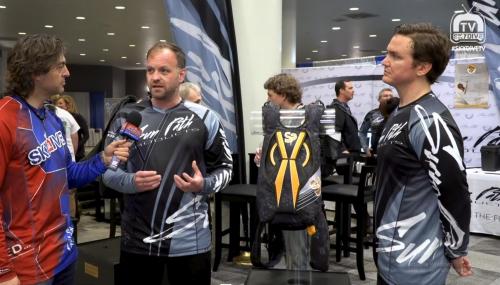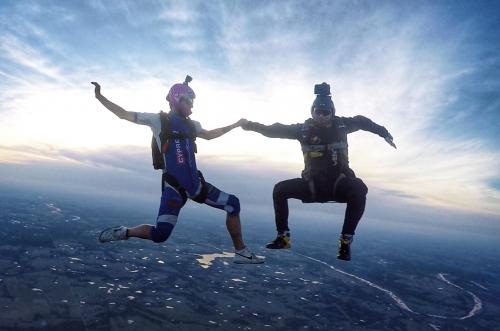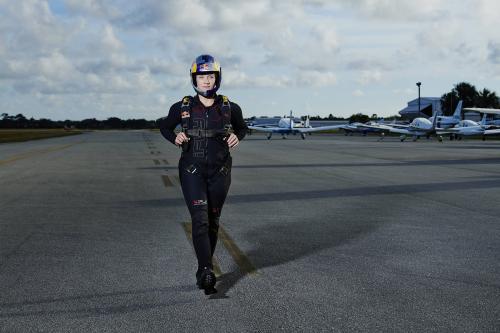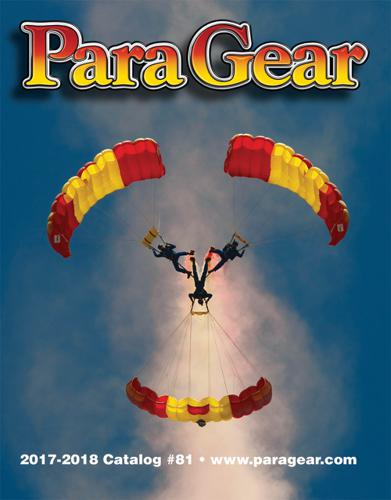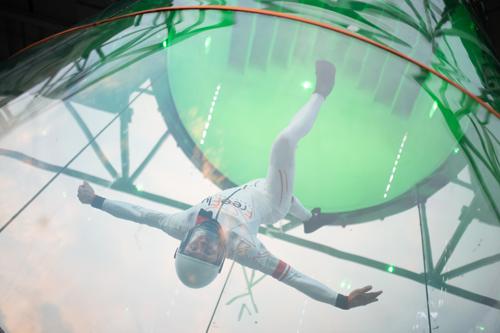Get Ready: Here Comes the Turbine 206
When Joel Strickland and I jumped in all fifty states this summer for our Down For 50 project, we saw the insides of a lot of 182s. A lot. That’s no surprise, of course--the 182 is the undisputed workhorse of our sport. It could be argued that the valiant little 182 keeps our sport going.
But what if there were a better way?
As it turns out, there is. I found out about it when Joel and I made our Oklahoma stop. Understandably, we fully expected to see another 182 out there. Instead, when we wandered across the hangar of the (super tidy, spacious and impressive) Oklahoma Skydiving Center to see what was parked outside, we had to double-take. There was a 206 parked out there. A 206 with a very funny face. A turbine. For reals.
Our first look at the toothy open grin of that jumpship was to start something of a minor obsession for me. First of all, it became apparent that its presence there had engendered the healthiest sport community of any smaller dropzone I’d ever visited. No wonder: that thing gets six jumpers to 14,000 feet in less than half the time it took the DZ’s old 182 to huff four folks up to 10k. The door is big. And this thing -- for lots of reasons -- puts turbine power within the reach of dropzones that never dreamed they’d be able to get there. I’ll let its champion, Andy Beck, cover all that. (Andy Beck is Co -DZO of the Oklahoma Skydiving Center, a small DZ between Tulsa and Oklahoma City, as well as the co-owner of BAM Aviation, which has been specializing in this conversion since Andy himself discovered its existence.)
Pretty cool, right?
I’ll leave the explanations to the expert. Below follows the conversation I had with Andy about this beautiful beast. If you’re not as enchanted with this plane as I am by the time we’re done here, I’ll be very surprised.
Q: What’s your love story with this plane?
Andy: My dropzone [the Oklahoma Skydiving Center] is somewhere between a small and a medium-sized DZ. For years, we were, like, man, we want a turbine airplane, just as instructors and fun jumpers.
It’s easy to relate to that. I grew up on a single airplane drop zone. That’s where I started; that’s how I learned to skydive: A single airplane 182 drop zone. When you’re in a situation like that, you spend your whole life sitting around, watching people skydive, doing tandems and AFFs, just praying that there’s an airplane load that has empty slots. And that’s okay, because that’s all you know. But then you go somewhere and you suddenly realize there’s a different model that means you can skydive more than once or twice a day. you see how much more time you have for the fun part of the sport in a turbine, compared to what you can get out of the 182 that’s waiting for you back home.
Since my wife Alyssa and I bought this dropzone four years ago, we wanted to bring that other model to our own DZ. The first thing we did -- immediately -- was to bring in a second 182, so we could have one for tandems and AFF and one for fun jumpers. I understand why people don’t want to mess with fun jumpers, but to me the reason that I think that you need the experienced-skydiver scene is because -- if you don’t -- then how do you convince anybody to do more than one jump? If all they ever watch is tandems, they’re one-and-done. They think that’s all there is.
If they have to go somewhere else to jump after AFF, that’s not good either. People want to stay where they learned. They know the people. They want to travel and visit, but they love their home. That’s where they want to be. That’s their home base -- their friends -- the people they like to jump with. To teach people to jump and then tell them to go somewhere else just seemed dumb to me. So you have to grow to support your experienced skydiver community.
Q: Why not just get an old King Air like everybody else?
Andy: Long story. As a DZO, when you start looking at turbine airplanes, yeah, you think, maybe I can afford a King Air, but the only ones that anybody sells that any small-to-medium DZ can afford are about worn out, and worn out King Airs are a huge maintenance situation.
Then, you think: I really love the Caravan. And that’s a cool plane. It is one of the starter-type turbine investments. But most of the Caravans worth having cost between $1.2 and $1.8 million dollars, and you’ve got 16 to 20 slots to fill. At a smaller DZ, you just can’t reliably fill it. That’s just not a very doable business model. And before, there really wasn’t anything that was, basically, half of a caravan.
So I kept looking. The 206 has been around forever as a skydiving plane, but it really has a bad reputation because -- with the standard configuration -- it’s super slow. In the Oklahoma summer, you can hardly get to 10,000 in one, even if you’ve got the turbo version. For our purposes, it’s just not much of a plane.
Then, one day, I heard about the new Pratt Whitney PT6 turbine 206 conversion from a fun jumper. It sounded like a myth, but I was intrigued, so I called the aircraft conversion inventor, Van Pray, who was partnering with Turbine Conversions on the Turbine 206 concept. Van has been around dropzones, skydiving, and airplanes all his life and turbine conversions has been modifying agricultural aircraft to turbines for decades. I asked Van to bring his plane down for a weekend so I could see if maybe this was going to be the answer to my problem. Turns out, it was better than I could have ever imagined.
Anyway, Van and Emiko Pray brought their plane down, and we basically rented it like a boogie for two different weekends to try it out. I wanted to see how it cash flowed; how much fuel it used. There is no way anybody could tell you that information without seeing it for yourself. Since I paid all the bills, I could really see how economical it was. After that, I just knew that’s what I had to do. We had to build one.
Q: What do the numbers look like? What does the turbine 206 specifically bring to the table here?
Andy: Well, you can get a 182 for about $60,000 dollars. The Turbine 206 goes for around $600,000 depending on airframe, engine, etc... So of course it’s expensive when you look at it like that. But you have to remember that what you’re actually getting for that is half of a Caravan. Depending on your airframe -- engines and all that -- the fuel burn is half of a caravan or less too.
Before I got the turbine 206, we had an average of three planes at OSC. We would always fly two, but on a lot of really busy days we would fly all three.
In the summer, with a 520, or a PPonk, or a higher-horsepower 182 that actually can go to 10,000 feet in a reasonable time, you burn 7 to 8.5 gallons of fuel alone. Obviously, when they’re full, heavy and hot, it’s more like 8 to 8.5 gallons, but when you’re flying cool, light loads you could do a little over 7 gallons. That’s what my average was, at least. The turbine 206, on the other hand, will average ten gallons consistently to 14,000 feet AGL.
The other big thing is that AV gas is getting a little bit harder to find in the first place, and the price of it is consistently higher than jet fuel pretty much anywhere you go, especially in more remote areas -- but if there’s a commercial airport anywhere around, no question, you can get jet fuel.
So: When you look at expenses, the turbine 206 doesn’t burn very much more fuel per load, and the fuel it burns costs less. You also get the industry standard Pratt Whitney PT6 dependability and reliability.
With the high-horsepower 182, I could count on two loads an hour: four people per load, to 10,000 feet. With the turbine 206, you get six people per load and you can do three loads per hour -- to 14,000 feet -- with one plane. Every hour throughout the day, you just keep getting farther ahead, because the plane doesn’t slow down with the heat. The density altitude doesn’t affect it the same way. It just goes and goes. On a good Saturday we do 30 loads in the 206 -- three loads an hour for 10-plus hours. We just fly and fly and fly.
Q: The fun jumper community here seems to be seeing some real benefits. These guys have crazy healthy jump numbers for being based at a small dropzone.
Andy: Yeah, we’re proud of that. The quality of every skydive is better, and that makes a difference to the bottom line, too. We wanted to offer the best possible experience to all of our jumpers!
In the last two years, we’ve finished way more A licenses and created way more fun jumpers, because on each skydive they’re not getting 25 to 30 seconds of freefall, they’re getting from 50 to 60 seconds on every jump. It’s like trying to ride a bike. If your parents let you ride a bike for 10 to 20 seconds, take your bike away, then give you another 10 to 20 seconds on it the following weekend, it is going to take a long time to learn how to ride a bike. Skydiving is way harder to learn than riding a bike. If you give them more time on task and more jump availability, people are going to learn and be better and safer skydivers. They’re more current. They’re more excited. They make more jumps. It just gets better in every direction.
Fun fact: We do 18,000-foot jumps occasionally, and we could even go higher than that if we wanted to. This plane climbs just as good at 18,000 feet as it does at 10,000 feet. It’s just a whole different beast. We have a lot of fun here.
Q: So when did BAM Aviation start doing the conversions?
Andy: That’s a funny story. When we built the first one, we had absolutely no intention of building more airplanes. That wasn’t why we did it in the first place. We did it for our dropzone. But, in the process of figuring out how to do it, we partnered up with Turbine Conversions and they made us an authorized installation center. They came and took a tour of our facilities, saw what we had and asked if we wanted to take on some more. This conversion is not crazy-hard, but it’s not just a straight, bolt-on modification and it takes real skill to do. It is a lot of sheet metal work. And I was lucky enough to have access to some real talent with Mike Palmer and Brian Wattenberger.
I myself am learning, but the two guys that work with me really are master mechanics. They’re very unassuming, but when you get in the shop and watch their creativity, it’s incredible. They are true masters of the trade; true craftsmen. There would be no airplane business if it wasn’t for Mike and Brian. That’s a fact. I mean: I’m the skydiving business owner, and the guy that came up with the idea to convert the first plane, but without the mechanics, there would be no BAM Aviation (which stands for Brian, Andy, Mike). That’s for sure.
At this point, it’s busy here. We have another one that we’re more than halfway through and several others in the works. We’re prepared to scale up, depending on need. I’m sure that the more people that know about it, the more people are going to be interested in it, because it the turbine 206 is a real option for that small/medium drop zone to be able to expand without going a million and a half dollars in debt. I do it because it’s good for my dropzone and it’s good for the sport.

